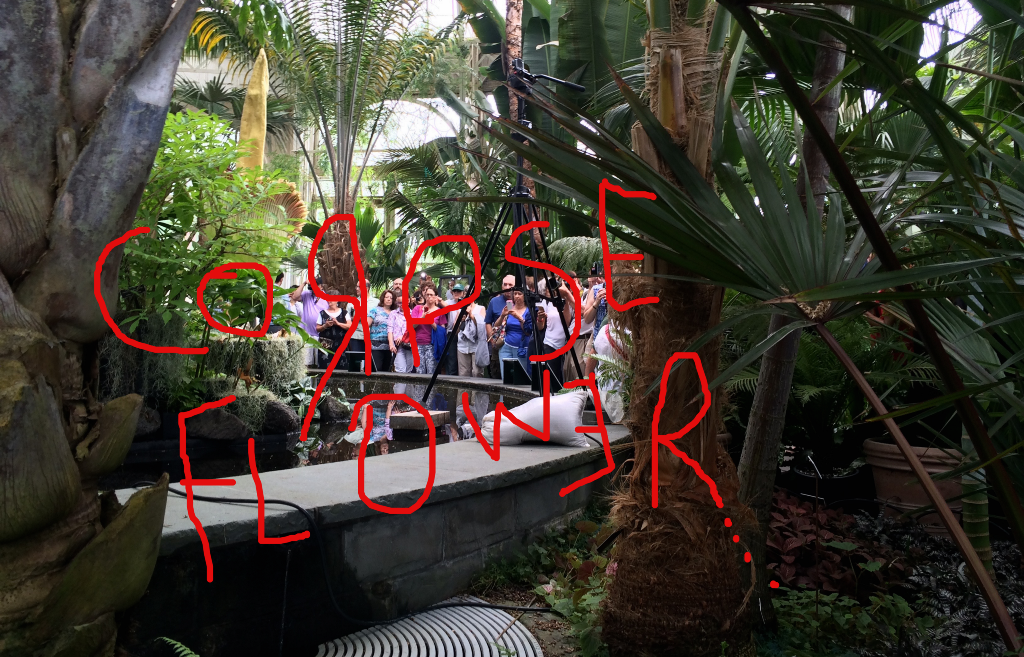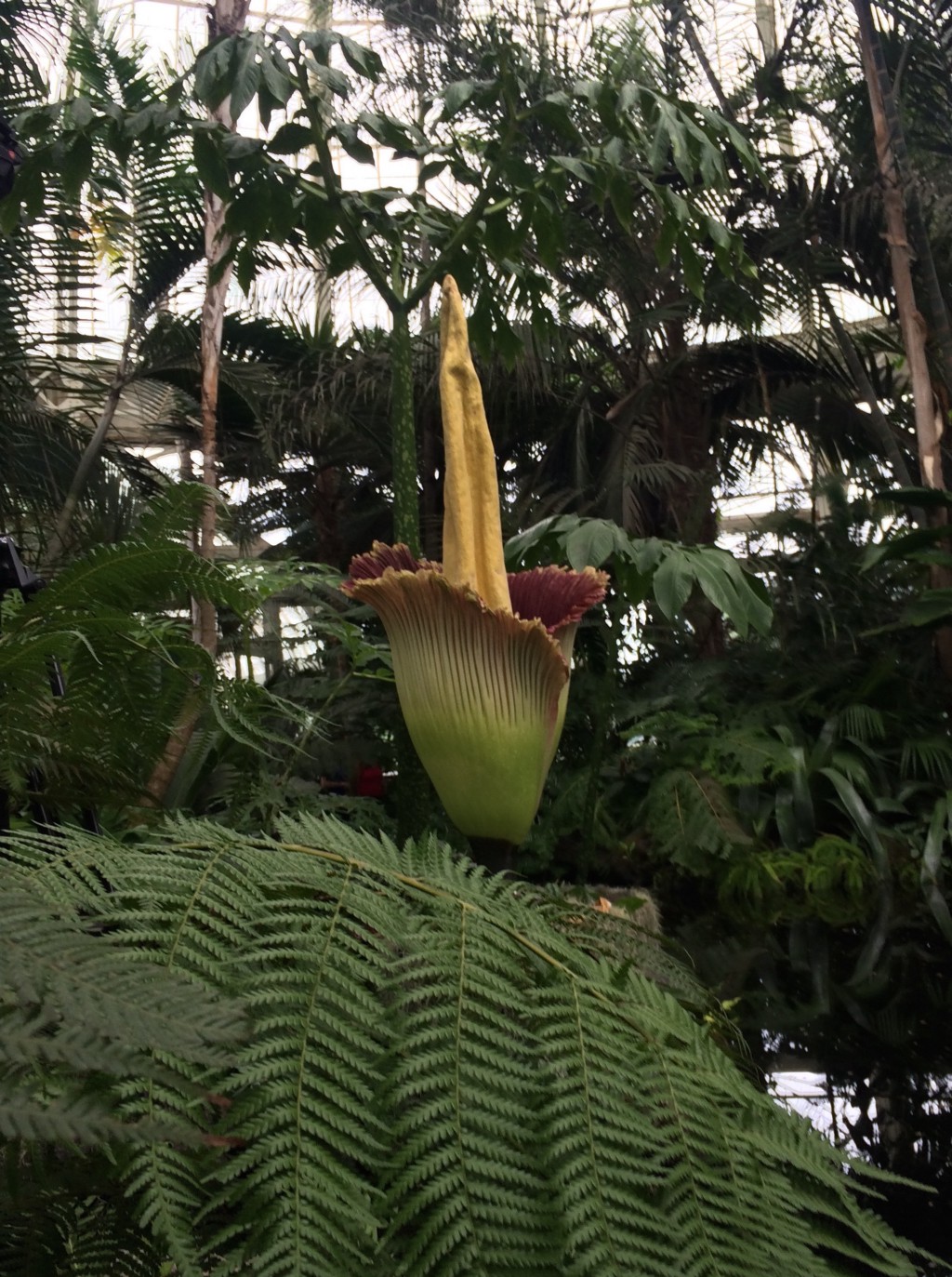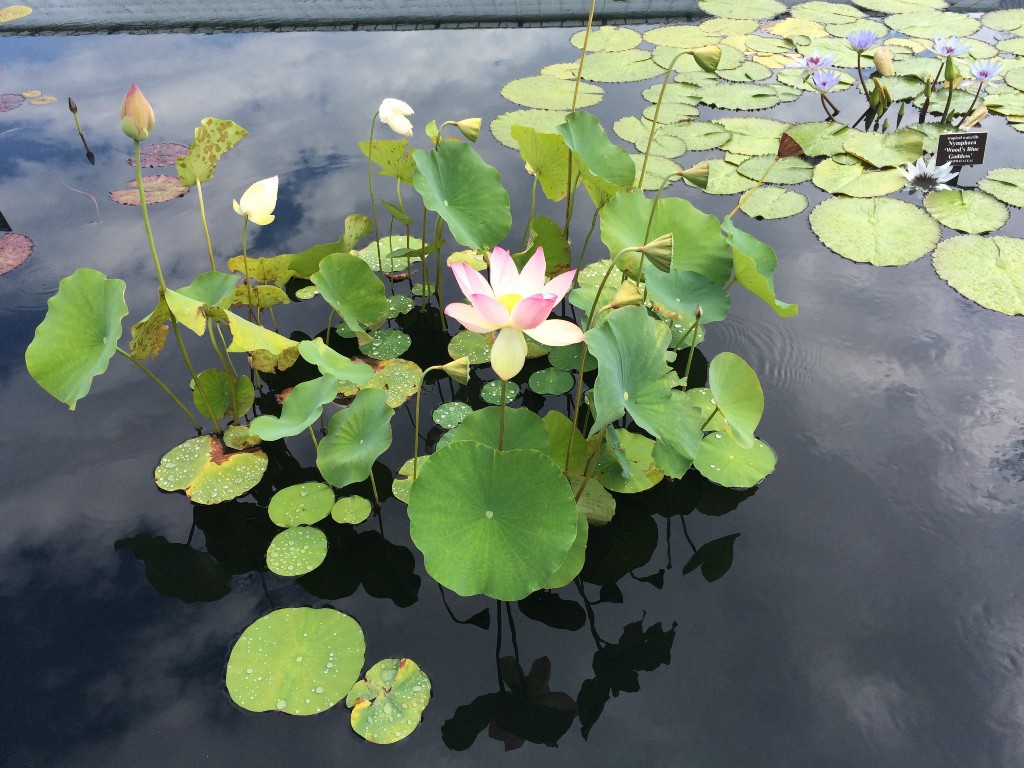Visiting Corpse Flower on Her Special Day

Past the herb garden and the giant Hibiscus flowers, beyond the winding line of malodorous plant tourists, and through the doors of the New York Botanical Garden’s Haupt Conservatory, you’ll find her. Our girl. Our stinky beast. Our corpse flower. She’s wilted now and if you missed her in her 24–36 hours of bloom, I’m sorry for you. She was truly disgusting.
The corpse flower, or Amorphophallus titanum, (which means essentially “giant misshapen penis”) (just telling you the truth), is native to western Sumatra and, at about six feet tall, is one of the largest flowers in the world. In its short blooming period, it emits a carrion-like scent to attract carnivorous pollinator flies and beetles, generating heat within itself to help the odor spread. It has a purple-y red inside to its lettuce-y spathe, not only to better trick flies and beetles into thinking it’s a carcass, but also to make them feel foolish once they realize they’ve fallen for such a thin ruse. Embarrassing. Plus, it’s a real “thing.” Because the corpse flower is difficult to grow, takes about ten years to bloom, and allegedly smells real bad, enthusiasts (dorks, let’s be honest) flock to catch glimpses of its short-lived plumage and smell-glimpses of its short-lived smell-plumage whenever the flowers are in bloom.
According to the University of Wisconsin’s corpse flower archive, only 157 corpsies (my nickname) bloomed between the years 1889 and 2008. But, get a load of this, a bunch have already bloomed in 2016 alone: two in Illinois (greedy), one in Florida, one in Missouri, and, just in the past few days, one in Indiana and one in New York. Damn! And get a load of this also: a handful more — in Washington D.C. and another in Florida (greedy) — are expected to bloom any day now! What accounts for all the corpsies? Sort of no one knows, but also maybe this, from the Wall Street Journal:
These plants all blooming within days of each other could come from the same lineage, in other words they might be plant “siblings” or “cousins,” [Daniel Janzen, a professor of biology at the University of Pennsylvania] said.
Corpse flowers were rare in the U.S. before the 1990s, said Emily Colletti, aroid collection curator at the Missouri Botanical Garden. But then a number of seed distributions occurred from about 2002 through 2008. A few or all of these synchronous blooms may come from one of these distributions, Ms. Colletti suggested.
Or maybe it is something more sinister…
Like…
Some sort of a something…

Before this past weekend, the New York Botanical Garden, located in the Bronx, about an hour and forty minutes away from me personally by train, not complaining, hadn’t had an in-bloom corpse flower since 1939. So when their flower began to bloom on the afternoon of July 28, I decided I should pay it a visit. Before planning my trip I called the garden to ask about how long the plant would smell while in bloom (24–36 hours), and later found out that information was widely available online. My apologies.

Twenty minutes after the NYBG opened its gates on the morning of July 29, the line to see the corpse flower was already about seventy people deep. Luckily for me, a friend of mine had arrived before I did, so I got to cut the line and stand where he was standing, near the front. Unfair? Maybe, but I’d also like to point out that it is “unfair” for you to judge me, someone who has never judged you even one time throughout the entire course of our friendship.
To be honest, I didn’t think the corpse flower would smell that bad. I thought, “How bad could it smell really?” I also thought, “Give me a break,” and, “Come on.” My cynicism (or optimism, depending on how much you like rotting flesh scent) (I love it) seemed justified after we were ushered into the conservatory. There, about thirty or so cramped onlookers were staring at the giant penis plant, taking selfies, and asking, “can you smell it?” “Can you smell it?” “I can’t smell it, can you smell it?”
I certainly smelled something. But my friend pointed out, aptly, that it was very hard to tell in the humid, 100-degree room on an already warm, wet day whether we were smelling the disgusting plant or merely the disgusting people surrounding the disgusting plant. Hm. I smelled harder and, hm, oh, yes, it was the people.

Luckily, noticing the corpse crowd wasn’t getting the nauseating experience it desired, a NYBG employee pointed a few of us to an area to the plant’s right, where she told us the smell was most pungent. And now I’ll insert some suspense, …, la-la-la, and then one more beat, and then yes: She was right.
It smelled.
Bad!!!!!!!!!!!!!!!!!
The smell came in waves, and after standing there for a few moments we got our first whiff.
I would describe the scent as summertime rotting animal carcass covered in disgusting cheese. This is a good description and very accurate. The “rotting animal carcass” association was immediate, though I tried to remember at what point in my life I would have smelled a rotting animal carcass and couldn’t really nail it down. In…a desert? I don’t think I’ve been near a rotting animal carcass in a desert. The woods? Not that I can recall. Zoo where all the animals are dead and rotting instead of alive and miserable, as a metaphor? No. I don’t go camping because why would you, so it’s not from camping. I guess the scent is more like when you walk by your neighbor’s trashcan and you smell something that you imagine is either a bunch of rotting meat or like maybe your neighbor threw away a cat. It was a familiar smell.

According to this blog post from Tim Pollak, floriculturist at the Chicago Botanic Garden, an analysis of the chemicals released by the penis-looking part of the corpse flower shows the smell is made up of:
“Dimethyl trisulfide (like limburger cheese), dimethyl disulfide, trimethylamine (rotting fish), isovaleric acid (sweaty socks), benzyl alcohol (sweet floral scent), phenol (like Chloraseptic), and indole (like mothballs).”
But what about the rotting flesh smell? Well, National Geographic says:
In addition, the aptly named compounds cadaverene and putrescine — produced when flesh breaks down — are found in other flowers of the Aroid family and are likely to be synthesized by A. titanum too.
So, there you have it. Those are some things I found online about the smell.

After standing in the smell spot and smelling the corpse flower for a few minutes, we’d finally had enough. At first we were desperate for the smell, and now the smell was too much. “I get it,” I thought. “I’ve finally had enough and now the smell is too much.” No, the corpse flower is not a classically “beautiful” flower and, no, it isn’t not named after a misshapen penis. But it does smell bad. And sometimes that’s more than enough.
The End
P.S.: Here’s another flower I saw:

🙂